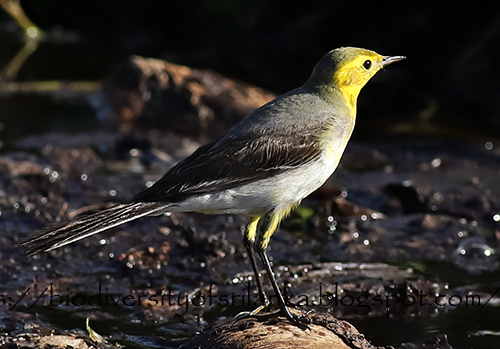English Post >>
Pages
- Home
- Flora of Sri Lanka
- Dragonflies & Damselflies of Sri Lanka
- Butterflies of Sri Lanka
- Freshwater Fishes of of Sri Lanka
- Amphibians of Sri Lanka
- Snakes of Sri Lanka
- Tetrapod Reptiles of Sri Lanka
- Mammals of Sri Lanka
- Resident Birds of Sri Lanka
- Migrant Birds of Sri Lanka
- Vagrant Birds of Sri Lanka
- Status Uncertain or Doubtful Birds of Sri Lanka
Sunday, April 7, 2024
අලු හැලපෙන්දා (Motacilla cinerera)
Sunday, January 21, 2024
White Wagtail/සුදු හැලපෙන්දා (Motacilla alba leucopsis)
සිංහලෙන් කියවන්න >>
Friday, January 6, 2023
හිසකහ හැලපෙන්දා/දෙහිකහ හැලපෙන්දා (Motacillia citreola)
ප්රධාන වශයෙන් වියලි කලාපයේ වගුරු බිම්, කුඹුරු සහ වෙනත් එවැනි විවෘත භූමි වලට සංචාරක පක්ෂීන් මෙරටට පැමිණෙන කාලයේ පැමිණෙන පක්ෂියෙකි. දුර්ලභ නමුත් සෑම වසරකම පාහේ වාර්තා වේ.
English Post >>
Saturday, December 31, 2022
Citrine Wagtail/හිසකහ හැලපෙන්දා/දෙහිකහ හැලපෙන්දා [Hisa kaha Halapendha/Dehikaha Halapendha] (Motacillia citreola)
Citrine wagtail is a rare but regular winter migrant to marshes, paddy fields and open country near water mainly in the dry lowlands.
සිංහලෙන් කියවන්න >>
Monday, November 21, 2022
සුදු හැලපෙන්දා (Motacilla alba dukhunensis)
දුර්ලභ නමුත් නිත්ය සංචාරක පක්ෂියෙකු වන සුදු හැලපෙන්දා සංචාරක පක්ෂීන් මෙරටට පැමිණෙන කාලයේදී පහත රට විවෘත බිම් වල සහ වගා බිම් වල, බොහෝවිට ජල මූලාශ්රයකට ආසන්නව පොළොව මත කුඩා කෘමීන් ගොදුරු කරගනිමින් හැසිරෙනු නිරීක්ෂණය කල හැක. නිතර තනි පක්ෂීන් ලෙස දැක ගත හැකි මුත් ඇතැම්විට විසිරුණු කුඩා රංචු ලෙසින් හෝ වෙනත් හැලපෙන්දන් විශේෂ සමගද නිරීක්ෂණය කල හැක. වෙනත් හැලපෙන්දන් මෙන්ම විශාල රංචු ලෙසින් සමූහ වශයෙන් පන් ගාලක් වැනි තැනක රාත්රී කාලය ගත කරයි.
English Post >>
Sunday, January 23, 2022
White Wagtail/සුදු හැලපෙන්දා (Motacilla alba dukhunensis)
White Wagtail is a rare but regular winter migrants to the lowlands. It can be seen on ground of open areas and cultivated lands, often close to water sources. Usually as solitary birds or may be as a scattered flock of few birds, sometimes also associated with other wagtails. It feeds entirely on small insects. As it is with other wagtails White Wagtail also roosts communally in large flocks in a reed bed or similar habitat.
Sub Species - Motacilla alba leucopsis >>
සිංහලෙන් කියවන්න >>
Thursday, March 25, 2021
කහ හැලපෙන්දා (Motacilla flava thunbergi)
මෙරටට පැමිණෙන සංචාරක පක්ෂියෙකු වන කහ හැලපෙන්දන් උප විශේෂ කිහිපයක්ම මෙරටින් වාර්තා වී ඇති මුත් ඒ අතරින් වඩාත්ම සුලභ වන්නේ දිවයින පුරාම තෘණභූමි සහ වගුරු බිම් වල හමුවන M.f. thunbergi උප වීශේෂයයි. ඊට අමතරව (M.f. bema, M.f lutea, M.f. melanogrisea සහ M.f. simillima යන උප විශේෂද දුර්ලභ හෝ ඉතාමත් දුර්ලභ ලෙස පහත රට වියලි කලාපයේ විවිධ ස්ථාන වලින් වරින් වර වාර්තා වී ඇත. මෙරට සිටින කාලය තුලදි කහ හැලපෙන්දන් විසිරුණු රංචු ලෙසින් තෘණභූමි, වියලී ගිය වැව් පිටි,කුඹුරු සහ වෙනත් එවැනි පරිසර පද්ධති වල ආහාර සොයමින් හැසිරෙන අතර රාත්රී කාලයේදී සමූහ වශයෙන් වගුරු වල වැවෙන පඳුරු හෝ පන් ගාල් අතර ලැග සිටී.
English Post >>
Sunday, December 30, 2018
Syke’s Yellow wagtail/කහ හැලපෙන්දා (Motacilla flava beema)
Tuesday, March 24, 2015
වන හැලපෙන්දා/Forest Wagtail (Dendronanthus indicus)
Tuesday, February 17, 2015
අලු හැලපෙන්දා/Grey Wagtail (Motacilla cinerera)
Tuesday, September 30, 2014
Vagrant Wagtails and Pipits (Family: Motacillidae) recorded in Sri Lanka
Confirmed vagrants
Unconfirmed vagrants:
Hoffmann, T. W., 1991. Notes from the Ceylon Bird Club, 1990. Loris, 19(3), 103-105.
Hoffmann, T. W., 1988. Notes from the Ceylon Bird Club 1987, A brief avifaunal survey. Loris, 18(1), 23-25
Hoffmann, T. W., 1985. Notes from the Ceylon Bird Club 1984. Loris, 17(1), 10-12.
Hoffmann, T. W., 1984. Notes from the Ceylon Bird Club 1983. Loris, 16(6), 299-301.
Hoffmann, T. W., 1983a. Notes from the Ceylon Birds Club. Loris, 16(3), 132-134.
Hoffmann, T. W., 1983. The 1983 Mid-January Duck (and Flamingo) Count in Sri Lanka. Loris, 16(3), 116-123.
Hoffmann, T. W., 1982. Notes from the Ceylon Bird Club 1981. Loris, 16(1), 38-40.
Hoffmann, T. W., 1981. Notes from the Ceylon Bird Club 1980. Loris, 15(5), "283-284,292".
Hoffmann, T. W., 1979. Note from the Ceylon Bird club 1978. Loris, 15(1), 6-8.
Hoffmann, T. W., 1978. Bird Club Notes (1977). Loris, 14(5), 289-290.
Hoffmann, T. W., 1977. Notes from the Ceylon Bird Club 1976. Loris, 14(3), 154-156.
Phillips W.W.A., 1978 Annotated checklist of the Birds of Ceylon (Sri Lanka) 1978 revised edition.
Siriwardana, U., 2005. Report from the Ceylon Bird Club for 2004. Loris, 24(1&2), 33-35
Warakagoda, D., 2004. Report from the Ceylon Bird Club for 2003 Loris, 23(5&6), 37-41










